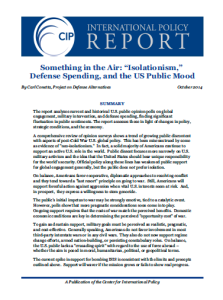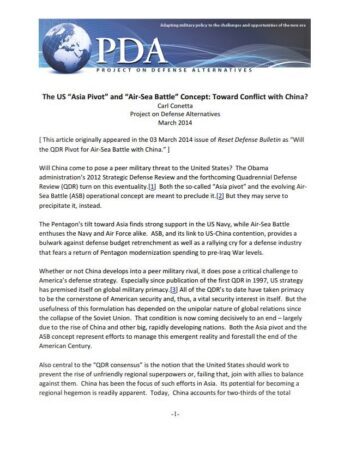by Charles Knight, letter to the editor of the Boston Globe, 24 Jan 2014. This post appeared first in PDA’s now archived Defense Strategy Review blog.

Preventing war with China requires diplomatic wisdom, not more US military investment. Nicholas Burns (The trouble with China, Op-ed, Jan. 16) cites a recent mini-crisis in the E.China Sea as a warning sign for “congressional leaders in both parties supporting deep cuts in the State Department and Pentagon budgets.”
However, the modest budget reductions that have been proposed — next year the Pentagon is actually getting a $20 billion raise — would in no way prevent the United States from performing shows of force such as the recent flight of B-52s through China’s newly claimed airspace in the East China Sea. The Pentagon’s budget would have to be cut in half to get close to touching overwhelming US military dominance in the Pacific.
A quick look at a map of the region will reveal that China has critical national interests in unencumbered access to the shipping lanes off its coasts and through the passages to the south. Accommodating these interests is the best path to peace in the long run.
America will be much better served by helping to establish an inclusive cooperative economic and security zone in the region, rather than pursuing an ultimately losing game of indefinitely overmatching China’s military power in its own neighborhood.
~~~~~~~~`
The trouble with China: It’s the responsibility of the US to prevent war over East China Sea islands
by Nicholas Burns, Boston Globe, 16 January 2014.
As the White House struggles to cope with a burning Middle East, another vital challenge is arising on the far horizon — China is flexing its muscles with real consequences for America’s future in Asia.
In the East China Sea, the United States worries about a stand-off between our ally Japan and Beijing over conflicting, historical claims to small, uninhabited islands the Japanese call the Senkakus and the Chinese call the Diaoyu. China opposes Japan’s ownership of the islands and, in November, announced creation of an Air Defense Identification Zone in the East China Sea that directly challenged the right of Japanese, American, and other aircraft to transit airspace in the area without prior notification to Beijing. China has made equally extravagant legal claims in the South China Sea against Filipino and Vietnamese territorial claims.
As my Harvard colleague, Graham Allison, recounts in the National Interest, China’s actions are playing out on a broad historic canvas with Beijing and Washington as the main actors. He reminds us of the “Thucydides Trap”— when, in past centuries, “a rapidly rising power rivals an established ruling power, trouble ensues. In 11 of 15 cases in which this has occurred in the past 500 years, the result was war.”
Conflict between the United States and China is far from inevitable. But the East and South China Seas crises illustrate the American challenge in working with China’s assertive new leadership. The United States and China are partners on a range of issues, from trade to climate change and proliferation. But they are also strategic rivals for power in Asia. That is why the White House should be firm that the United States and its allies won’t be bullied by China’s peremptory and unilateral territorial claims.
The immediate challenge is in the East China Sea. Tokyo defends its long possession of the islands through naval and air patrols while Beijing counters with its own naval vessels and aircraft to contest it. The obvious risk is potential collision by two powerful militaries at sea and in the air. The stakes are very high for the United States as our defense treaty with Japan obligates us to come to its assistance in the event of conflict with China.
The United States has rightly stood by Japan against China’s unilateral claims. Washington is also counseling China to gain better control of the often-willful People’s Liberation Army and submit its territorial claims to international adjudication rather than assert them by fiat and intimidation.
To be fair, however, Washington is also advising Japan’s nationalist Prime Minister, Shinzo Abe, to lower the temperature in his rivalry with China. His recent visit to the Yasukuni Shrine, where war criminals from the Second World War are buried, as well as Japan’s refusal to acknowledge the horrific actions of its military during the Second World War, are unnecessarily provocative to the Chinese, South Korean, and Filipino peoples.
As the United States seeks to keep the peace in the East China Sea, the immediate danger is not so much that Japan or China will decide to launch a war for the islands but that they might stumble into conflict by mistake or miscalculation.
British historian Margaret MacMillan warns of such a risk in a recent Brookings Institution essay. She recounts the improbable and unplanned events that led to the outbreak of war in 1914 in which 16 million combatants and civilians eventually perished. Her essay is a direct warning — we can’t take the current Great Power peace for granted. Human folly, frailty, and hubris could lead the great powers of our time — among them China, Japan, and even the United States — into a conflagration we never believed was possible. “The one-hundredth anniversary of 1914 should make us reflect anew,” she warned, “on our vulnerability to human error, sudden catastrophe, and sheer accident.”
The East China Sea Crisis and the lessons of World War I remind Americans of a final stark reality — global peace and security still depends on us more than any other country. It is thus essential that we remain the world’s strongest diplomatic and military power. Congressional leaders in both parties supporting deep cuts in the State Department and Pentagon budgets should remember that in Asia, the Middle East, and beyond, we are still, as Madeleine Albright once rightly claimed, the world’s “indispensable” nation.
Nicholas Burns is a professor of the practice of diplomacy and international politics at Harvard’s Kennedy School of Government.




